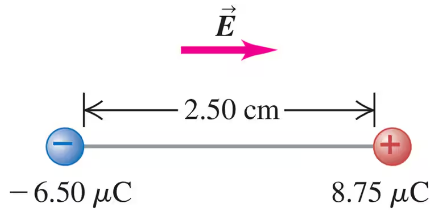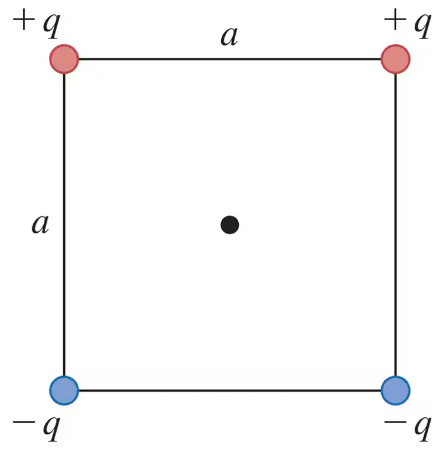 Back
BackProblem 2
Lightning occurs when there is a flow of electric charge (principally electrons) between the ground and a thundercloud. The maximum rate of charge flow in a lightning bolt is about C/s; this lasts for ms or less. How much charge flows between the ground and the cloud in this time? How many electrons flow during this time?
Problem 3
If a proton and an electron are released when they are m apart (a typical atomic distance), find the initial acceleration of each particle.
Problem 6
Two small spheres spaced cm apart have equal charge. How many excess electrons must be present on each sphere if the magnitude of the force of repulsion between them is N?
Problem 8a
Two small aluminum spheres, each having mass kg, are separated by cm. How many electrons does each sphere contain? (The atomic mass of aluminum is g/mol, and its atomic number is .)
Problem 8b
Two small aluminum spheres, each having mass kg, are separated by cm. How many electrons would have to be removed from one sphere and added to the other to cause an attractive force between the spheres of magnitude N (roughly ton)? Assume that the spheres may be treated as point charges.
Problem 8c
Two small aluminum spheres, each having mass kg, are separated by cm. What fraction of all the electrons in each sphere does this represent?
Problem 9a
Two small plastic spheres are given positive electric charges. When they are cm apart, the repulsive force between them has magnitude N. What is the charge on each sphere if the two charges are equal?
Problem 9b
Two small plastic spheres are given positive electric charges. When they are cm apart, the repulsive force between them has magnitude N. What is the charge on each sphere if one sphere has four times the charge of the other?
Problem 12b
The nuclei of large atoms, such as uranium, with protons, can be modeled as spherically symmetric spheres of charge. The radius of the uranium nucleus is approximately m. What magnitude of electric field does it produce at the distance of the electrons, which is about m?
Problem 13
Three point charges are arranged on a line. Charge nC and is at the origin. Charge nC and is at cm. Charge is at cm. What is (magnitude and sign) if the net force on is zero?
Problem 16
Three point charges are arranged along the -axis. Charge C is at the origin, and charge C is at m. Charge C. Where is located if the net force on is N in the -direction?
Problem 20a
A uniform electric field exists in the region between two oppositely charged plane parallel plates. A proton is released from rest at the surface of the positively charged plate and strikes the surface of the opposite plate, cm distant from the first, in a time interval of s. Find the magnitude of the electric field.
Problem 20b
A uniform electric field exists in the region between two oppositely charged plane parallel plates. A proton is released from rest at the surface of the positively charged plate and strikes the surface of the opposite plate, cm distant from the first, in a time interval of s. Find the speed of the proton when it strikes the negatively charged plate.
Problem 23a
A proton is traveling horizontally to the right at m/s. Find the magnitude and direction of the weakest electric field that can bring the proton uniformly to rest over a distance of cm.
Problem 23b
A proton is traveling horizontally to the right at m/s. How much time does it take the proton to stop after entering the field?
Problem 23c
A proton is traveling horizontally to the right at m/s. What minimum field (magnitude and direction) would be needed to stop an electron under the conditions of part (a)? Note: Part (a) asks for how much time does it take the proton to stop after entering the field.
Problem 26a
A -mC point charge is glued down on a horizontal frictionless table. It is tied to a -mC point charge by a light, nonconducting -cm wire. A uniform electric field of magnitude is directed parallel to the wire, as shown in Fig. E. Find the tension in the wire.
Problem 26b
A -mC point charge is glued down on a horizontal frictionless table. It is tied to a -mC point charge by a light, nonconducting -cm wire. A uniform electric field of magnitude is directed parallel to the wire, as shown in Fig. E. What would the tension be if both charges were negative?
Problem 36a
A -nC point charge is at the origin, and a second -nC point charge is on the -axis at m. Find the electric field (magnitude and direction) at each of the following points on the -axis: (i) m; (ii) m; (iii) m.
Problem 36b
A -nC point charge is at the origin, and a second -nC point charge is on the -axis at m. Find the net electric force that the two charges would exert on an electron placed at each point in part (a). Note: Part (a) asked to find the electric field (magnitude and direction) at each of the following points on the -axis: (i) m; (ii) m; (iii) m.
Problem 38
A point charge is placed at each corner of a square with side length . All charges have magnitude . Two of the charges are positive and two are negative (Fig. E). What is the direction of the net electric field at the center of the square due to the four charges, and what is its magnitude in terms of and ?
Problem 44
A point charge nC is at the point m, m, and a second point charge nC is at the point m, . Calculate the magnitude and direction of the net electric field at the origin due to these two point charges.
Problem 48
A very long, straight wire has charge per unit length C/m. At what distance from the wire is the electric field magnitude equal to N/C?
Problem 51b
Point charges nC and nC are separated by mm, forming an electric dipole. The charges are in a uniform electric field whose direction makes an angle of ° with the line connecting the charges. What is the magnitude of this field if the torque exerted on the dipole has magnitude Nm?
Problem 53a
An electric dipole with dipole moment is in a uniform external electric field . Find the orientations of the dipole for which the torque on the dipole is zero.
Problem 53b
An electric dipole with dipole moment is in a uniform external electric field . Which of the orientations in part (a) is stable, and which is unstable? (Hint: Consider a small rotation away from the equilibrium position and see what happens.) Note: Part (a) asked to find the orientations of the dipole for which the torque on the dipole is zero.
Problem 53c
An electric dipole with dipole moment is in a uniform external electric field . Show that for the stable orientation in part (b), the dipole's own electric field tends to oppose the external field. Note: Part (b) asked which of the orientations in part (a) is stable, and which is unstable? (Hint: Consider a small rotation away from the equilibrium position and see what happens.) Also, part (a) asked to find the orientations of the dipole for which the torque on the dipole is zero.
Problem 54
The dipole moment of the water molecule (H2O) is Cm. Consider a water molecule located at the origin whose dipole moment points in the -direction. A chlorine ion (Cl-), of charge C, is located at m. Find the magnitude and direction of the electric force that the water molecule exerts on the chlorine ion. Is this force attractive or repulsive? Assume that is much larger than the separation between the charges in the dipole, so that the approximate expression for the electric field along the dipole axis derived in Example can be used.


